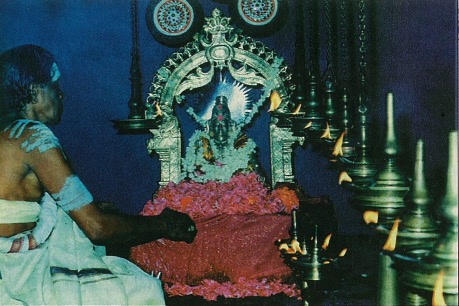With these three videos, there is no need to leave home to have some quality religious time
Pilgrimage to sabarimala,” a re- markable video production released two years back by the Madras-based Vedik-India Society, is just circulating in the West. It combines dramatic footage of the yearly pilgrimage to the mountain home of Lord Ayyappan in Kerala, with a reenactment of the 72-kilometer jungle trek to the shrine. The result is a professional 90-minute film which begins with a swamiye, as each pilgrim is called, taking vows and putting on the sacred chain to mark his commencement of 41 days of sadhanas (spiritual practices) which define the traditional pilgrimage. The detail of preparations before departure and observances en route make this practically a “how to” manual for would-be pilgrims. It recounts faithfully the Southern tradition, with its emphasis upon austerity, strict adherence to the rules of the yamas and niyamas and the arduous barefoot and barechested hike through remote hill country to the temple. The idea of driving in and starting a few kilometers away—as most do these days—is not even mentioned as an option. The temple priests cooperated fully in the production, even setting up a temporary sanctum sanctorum (pictured) for the filming.
Narrator Ramesh Elaman provides an informative commentary on the history of Sabarimala and the worship of Lord Ayyappan, as well as detailed philosophic explanations of the practices. For mantra, we are told, “The vibrations set up by chanting aum are so powerful they arouse and transform every atom in the body and awaken the spiritual power of the mind.” The philosophy is Agamic Saivite, with its focus upon the progressive path to God through service, worship, yoga and God Realization under the guru’s guidance.
Pilgrimage to Sabarimala is a right-on-target presentation of Hindu thought and practice, though ironically its producer, former film-actor M.M. Alex, is a Christian. Future film projects by the Vedik-India Society include In Search of Hinduism with 108 episodes covering Hindu history, scriptures and traditions, and Brahmavidya Yatra, a tour of India’s temples. Contact: Vedik-India Society, Sapta Swa-ra, 57, First Avenue, Ashok Nagar, Madras 600043, South India.
The Cosmic Dance of Siva:
Seldom does so much information come packaged with such sheer enjoyment. Against a backdrop of famous Indian Siva temples, producer Deben Bhattacharya deftly conveys the profound mysticism of Siva’s dance. His verbal explanations are then delightfully translated into the language of dance by virtuoso bharata natyam performers Raja and Radha Reddy. Mudra, hand gesture, is explained, for example, then, as we view nothing but Raja’s right hand, he glides through dozens of mudras—holding viewers rapt with nothing but his bare fingers! In another, he enacts rapid-fire the eight emotions (rasas)—love, heroism, sadness, wonder, laughter, fear, disgust, anger and peace. At the film’s climax, the narrator switches to physics and mathematics. The Reddy’s dance upon a large fractal, a complex mathematically-generated shape which approximates forms of nature from snow-flakes to the distribution of galaxies in the universe. Though new to science, such underlying rhythms are what Hindus have always called “Siva’s Cosmic Dance.” Contact: Jeffrey Norton Publishers, Inc., 96 Broad Street, Guilford, Connecticut 06437 USA.
Museum-Quality Puja
Sackler gallery produced Puja, Expressions of Hindu Devotion in conjunction with their Washington, D.C., exhibition of the same name [see page 22-25]. Shown as part of their tour, the short video is intended to explain the Hindu way of worship to non-Hindu exhibition visitors. Scenes from India and the USA are interspersed with first and second-generation Amer-i-can Hindus explaining wor-ship in personal ways. Nitya Nagarajan, a young international trade analyst, shared words she silently utters in prayers to Lord Ganesha, “OK, I’m going to start this task. Please make sure that I’m able to finish it properly.”
This is a useful video for its artful photography and crisp and accurate explanations of contemporary Hindu religious customs. The main sequence is about twelve minutes, making it suitable for short TV programming. For the hearing impaired, a second version with English-language captions and a few additional scenes from India fills out the half-hour documentary.
Contact: Arthur M. Sackler Gallery, Smithsonian In–sti-tute, Washington, D.C., 20560 USA.


